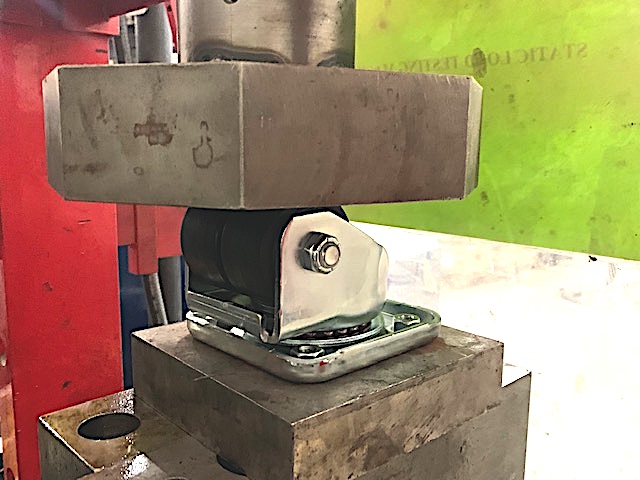Brakes: The Essential Option
There are many things that you might want to be unstoppable but casters aren’t one of them. Brakes are a critical caster component and choosing the right brake is a key factor in both safety and performance. This edition of CasterU provides a rundown of the brake options that we offer including the features and benefits for each one.
Side Lock Brake (SLB)
![7000 Series: S7006-A38H-UG-RB-SLB [Zinc Finish]](https://i0.wp.com/algood-casters.com/wp-content/uploads/2024/07/Algood-Caster-7000_Series-S7006-A38H-UG-RB-SLB.png?resize=891%2C891&ssl=1)
Features
• Foot Activated
• Yoke is pressed against wheel and creates positive contact with hub
• Available with larger pedal for use with pneumatic wheels
• Can be used on stainless steel casters
Benefits
• Economical
• Ideal for wheels where positive contact with the tread is difficult
• Larger pedal brings ease of activation
Top Lock Brake (TLB)
![MAXX™ Series: SE6563-A38H-RXW-RB-TLB2 [Zinc Finish]](https://i0.wp.com/algood-casters.com/wp-content/uploads/2023/08/Algood-Casters-6503_Series-S6563-A38H-RXW-RB-TLB2.png?resize=891%2C891&ssl=1)
Features
• Activated by side mounted pedal
• Creates positive contact with top of wheel tread
• Available with polyurethane coating on actuator
Benefits
• Well suited for wheels with softer tread
• Better engagement than SLB
• Coated actuator can be used with metal wheels
• Can be used in high temperature environments
iLock™ (iLK & iLK2)
![MAXX™ Series: SE6563-A38H-RXW-RB-TG-iLK [Zinc Finish]](https://i0.wp.com/algood-casters.com/wp-content/uploads/2023/08/Algood-Casters-MAXX_Series-S6563-A38H-RXW-RB-TG-iLK.png?resize=891%2C891&ssl=1)
Features
• Attractive design
• Locks swivel and wheel
• 4-position lock available
• Foot activated, engages easily
• Made of high impact nylon
• Mechanism includes high tensile spring with rubber layer
• Modular – can be added to an existing caster
Benefits
• Securely locks hard and soft wheels
• Can be used on high capacity casters
• Keeps caster square
• Moisture friendly, won’t rust
• Increases longevity
• Easy to engage, doesn’t damage shoes
• iLock for EMAXX™ Series (iLK2) includes elongated pedal with ridges that provides easier access and better grip
Double Lock Brake (DLB)
![2309 Series: S2359-A27D-HTPH-DLB [Zinc Finish]](https://i0.wp.com/algood-casters.com/wp-content/uploads/2023/10/Algood-Caster-2309_Series-S2359-A27D-HTPH-DLB.png?resize=800%2C800&ssl=1)
Features
• Locks both swivel and wheel
• Available in aluminum
• Foot activated
• Incorporated into the frame of the caster
• Available in aluminum (DLB2)
Benefits
• Provides more secure positive contact
• Secures equipment, preventing all movement
• Adds safety, prevents accidents
• Can be used in high temp applications
PolyCam Brake (PCB)

Features
• Foot activated
• PolyCam rollers made of Envirothane™
Benefits
• Designed to secure heavy duty loads
• Secures direct pressure on the contact face providing a dependable brake
Pedal Wheel Brake (PWB)

Features
• Economical add-on
• Made of plastic
• Direct contact between mechanism and wheel
Benefits
• Can be installed on-site
• Easily engaged
• Provides secure positive lock
Universal Wheel Brake (UWB)

Features
• Positive lock brake that is pre-welded to the fork of a caster
• Can be customized to the angle of operation
• Allows for forward or reverse movement
• Fully adjustable including the brake force and the position on the wheel
Benefits
• Can be adjusted to maintain contact as wheel wears
• Can accommodate soft or hard wheels
• Can be adjusted to meet floor conditions
• Can be used on casters with higher capacities
Thumb Screw Brake (TSB)

Features
• Hand tightened
• Creates positive contact between lock and wheel
Benefits
• Economical
• Accessibility on low profile casters
• Easy to engage
Position Swivel Lock (PSL)
The position swivel lock functions independently from any of the braking mechanisms on the caster. The PSL only locks the swivel mechanism, it does not act as a brake for the caster.

Features
• Securely locks swivel mechanism
• Comes welded to caster or can be added on
Benefits
• Converts swivel caster to rigid
• Can be installed on site
• Restricts equipment to movement in one direction only






![6809 Series: S6859-A45H-MPU-RB [304 Stainless Steel]](https://i0.wp.com/algood-casters.com/wp-content/uploads/2023/07/Algood-Caster-6809_Series-S6859-A45H-MPU-RB.png?resize=891%2C891&ssl=1)
![MAXX9 Series: S6559-A38H-NYNW-RB [304 Stainless Steel]](https://i0.wp.com/algood-casters.com/wp-content/uploads/2023/07/Algood-Caster-MAXX9_Series-S6559-A38H-NYNW-RB.png?resize=891%2C891&ssl=1)












![Mighty Maxx Series: S65253-B29F-RXW2-RB [Zinc Finish]](https://i0.wp.com/algood-casters.com/wp-content/uploads/2023/07/Algood-Caster-MIGHTY_MAXX-S65253-B29F-RXW2-RB.png?resize=891%2C891&ssl=1)
![8000 Series: 8022-A27D-PROF [Zinc Finish]](https://i0.wp.com/algood-casters.com/wp-content/uploads/2023/05/Algood-Renders-8000_Series-S8022-A27D-PROF.png?resize=891%2C891&ssl=1)
![5400 Series: S5433-A38F-RX-RB-iLK [Zinc Finish]](https://i0.wp.com/algood-casters.com/wp-content/uploads/2023/06/Algood-iLock-Compatible-S5433-A38F-RX-RB-iLK.png?resize=891%2C891&ssl=1)

![5000 Series: S5053-.5-13X1HO-PROF-PB-TG [Zinc Finish]](https://i0.wp.com/algood-casters.com/wp-content/uploads/2023/08/Algood-Casters-5000_Series-S5053-.5-13X1HO-PROF-PB-TG.png?resize=891%2C891&ssl=1)
![2100 Series: S2105-.5HOLE-PROFB-PB-TG [Zinc Finish]](https://i0.wp.com/algood-casters.com/wp-content/uploads/2023/10/Algood-Casters-2103_Series-S2105-.5HOLE-PROFB-PB-TG.png?resize=800%2C800&ssl=1)


